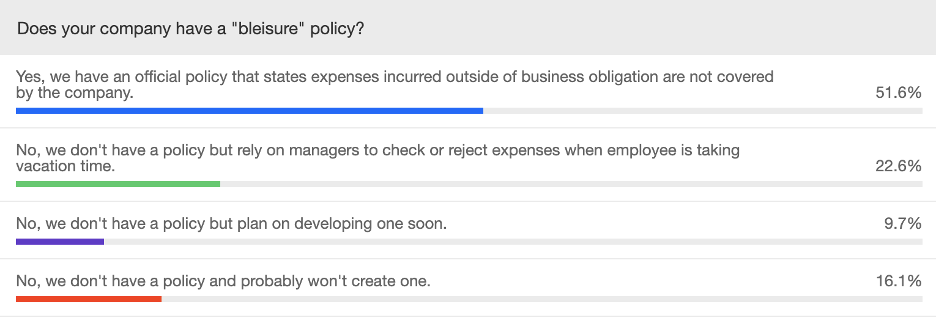Travel and Expense
4 Insights for CFOs as Travel Costs Emerge
Returning to business travel is high on the agenda for many organizations. Brian Vance, VP of Finance at SAP Concur, recently asked a panel of thought leaders for their insights on four key travel topics, including:
- Is the lack of travel costing your company?
- Distinguishing the blurred line between company and leisure travel
- A shift in power on spend and travel preferences
- Balancing flexibility with cost control
96% of employees are willing to travel in the next 12 months
- Wakefield Global Business Traveler Report 2021
Panelists:
- Pete Desiato – Managing Director for Ernst & Young LLP
- Julie A. MacFarlane – Finance Services Division Indirect Services for Caterpillar
- Tammy McEntire – Senior Director Shared Services for Spectrum Brands, Inc.
Listen to the full webinar here.
1. Is the lack of travel costing your company?
Employees have shifted from worry and anxiety about travel to eagerness to get back on the road. According to a recent Wakefield survey, it’s clear why: 45% of respondents feel they are unable to develop or maintain business connections when doing so completely virtually, which could be affecting attrition of new customers, as well as the retention of existing ones.
Although employees are returning to travel, it’s still not completely back to normal, so it’s important to determine when it’s essential to make a business trip. Pete Desiato, Managing Director for EY, shared that, “It’s important to have a framework that’s focused on ‘does the trip make sense from a business perspective?’” He recommended looking at four factors:
- Will it strengthen the business relationship?
- Does it drive revenue?
- Are the timing and frequency right?
- Is it safe?
Desiato also added that trying to build ROI models around business travel is nearly impossible and doesn’t suggest companies go down that path.
Evaluating these four questions before sending an employee on a business trip can help build and maintain both internal and external relationships, while keeping travel to an essential-only occurrence.
2. Distinguishing the blurred line between company and leisure travel
When considering how expensive it can be to travel – not to mention the time to get to and from a destination – the return to travel has seen the emergence of “bleisure” travel: travel where the intention is business, but the employee tacks on as least one vacation day. In fact, the Wakefield survey found that 89% of respondents will add personal vacation time onto a business trip in the next 12 months.
Employees see this as an important perk of their jobs. However, there can be risks associated with this practice, so it’s important to distinguish the blurred lines between what is considered business and what is leisure.
Brian Vance, VP of Finance at SAP Concur shares three recommendations to help your organization control potential costs of “bleisure” travel:
- Recommunicate, or create, your organization’s policy around “bleisure” travel.
- Have your team closely check costs and make sure only business-related expenses are getting reimbursed.
- Consider using an audit service that combines Artificial Intelligence (AI) and Machine Learning (ML) to audit expense reports for anything unusual.
Julie A. MacFarlane, Finance Services Division at Caterpillar, had some valuable insights on how important implementing an auditing service has been to catching and preventing non-compliant spending behavior.
She explained how, when manually processing expenses, it was only possible to look at one report at a time. “What they couldn’t see was the pattern from that individual traveler,” shared MacFarlane. Since Caterpillar has adopted an auditing solution that utilizes AI and ML, auditors are able to see the bigger picture, allowing them to spot potential non-compliant behavior and prevent it from happening again. “Now, because people know that it’s out there and there’s a potential to get caught, or visibility brought to it, people are more cautious about having things like that happen,” MacFarlane added.
An automated auditing process allows employees to enjoy the perk of “bleisure” travel, while ensuring they maintain policy compliance.
 Source: Evolution of Travel Webinar, September 2021, SAP Concur
Source: Evolution of Travel Webinar, September 2021, SAP Concur
3. A shift in power on spend and travel preferences
Considering the return to travel has risks associated, employees are making it clear that they want to have a say in how they get back on the road.
40% of employees would prefer to sit next to a crying toddler, rather than relinquish control over how they travel.
- Wakefield Global Business Traveler Report 2021
All the panelists agreed on the importance of keeping open lines of communication with their employees, as well as making it easier to return to business travel with the use of a corporate card program.
Tammy McEntire, a Senior Director at Spectrum Brands, Inc., explained how they host monthly roundtables with policy admins and travel & expense superusers. “As we get back into travel, there’s a need to go outside of the policy on some of these things, and so we’re trying to figure out why and how we can implement that into our tools and some of our policies,” shared McEntire. “As we go to do upgrades of our travel and expense, or change out services, we want to make sure that this group is involved and that it’s a feedback loop.”
Desiato shared his thoughts on how a corporate card program can make traveling easier for employees, as well as ensure spend compliance. “Corporate cards are a key control point of the business, and provide lots of benefits,” he said, such as:
- Control: know exactly what was spent and where
- Tax rules: reduce the amount of receipts employees need to submit
- Rewards: allow employees to reap some of the benefits of travel dollars or miles earned from card spending
- Rebates: enable the organization to collect card rebates
Providing an open line of communication with employees and implementing some of their suggestions, shows your organization cares about the thoughts and feelings regarding the return to travel. And once they’re back on the road, smoothing out the process for employees to travel is a win-win for both parties – such as issuing corporate cards.
4. Balancing flexibility with cost control
Employees are looking for flexibility to feel safe and secure when they return to business travel, but it’s important to not let costs spiral out of control due to too much flexibility.
A few areas business travelers may be looking for flexibility towards are:
- Preferred accommodations and methods of travel
- How long the trip will be
- The ability to change travel plans without repercussions
It all comes down to a balancing act between meeting your travelers wants and needs, versus what is cost effective for the organization. “We’re trying to listen to the concern of our travelers and put better tools in their hands,” shared McEntire, “such as on smartphones and then negotiating better rates at their preferred locations when they’re not inside the booking tool.” Additionally, all three panelists agreed that having travel and expense on one platform is extremely beneficial to gaining visibility into all your organization’s data.
Listen to the full webinar to get all the data and insights shared by our panelists.
